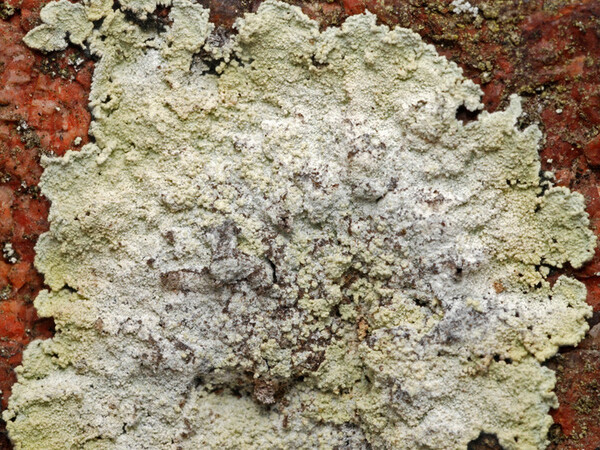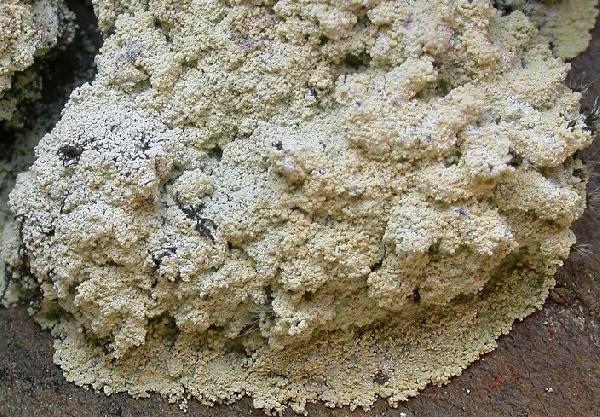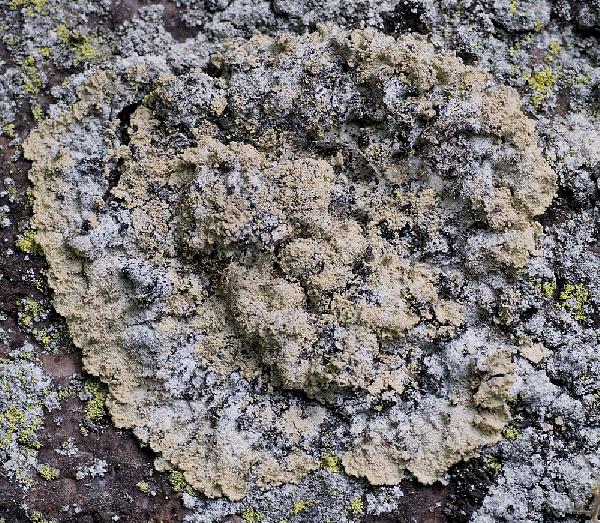Lepraria membranacea (Dicks.) Vain.
Acta Soc. Fauna Fl. Fenn., 49, 2: 265, 1921. Basionym: Lichen membranaceus Dicks. - Fasc. Pl. Crypt. Brit., 2: 21, tab. 6, fig. 1, 1790.
Synonyms: Amphiloma lanuginosum (Ach.) Nyl.; Crocynia lanuginosa (Ach.) Hue; Crocynia membranacea (Dicks.) Zahlbr.; Leproloma lanuginosum (Ach.) Nyl.; Leproloma membranaceum (Dicks.) Vain.; Pannaria lanuginosa (Ach.) Körb.; Psoroma lanuginosum (Ach.) Müll. Arg.
Distribution: N - Frl (Baruffo & al. 2006), TAA (Caniglia & al. 2002, Nascimbene 2005b, 2006c, 2007b, Nascimbene & al. 2022), Lomb (Nascimbene 2006, Abramini & al. 2008, Gheza 2018), Piem (Baruffo & al. 2006), VA (Piervittori & Isocrono 1999, Baruffo & al. 2006), Emil (Fariselli & al. 2020), Lig (S- L43503). C - Tosc (Baruffo & al. 2006), Umb (Panfili 2000, Ravera & al. 2006), Laz, Sar (Nöske 2000, Zedda 2000a, 2002, Zedda & al. 2001, Baruffo & al. 2006). S - Cal (Puntillo 1996).
Description: Thallus leprose, pale yellowish (at least in marginal parts) to cream-coloured, forming a very well-delimited, lobed, membrane-like rosette, the lobes to 3.5 mm wide, with raised, often wavy margins, and a brownish hypothallus. Surface covered in a soft mass of soredia-like, 40-120 μm wide granules, sometimes gathered into up to 300 μm wide aggregates, especially in the central parts of thallus, often with short projecting hyphae. Medulla distinct, white in upper part, brownish in lower part, forming a grey to brown hypothallus-like layer. Photobiont chlorococcoid. Spot tests: K+ yellow to orange (rarely K-), C- or C+ yellow, P+ orange-red, UV-. Chemistry: pannaric acid (major) with satellite dibenzofurans (minor to traces), roccellic/angardianic acid (rarely absent), atranorin (major to trace).Note: on more or less steeply inclined and rain-sheltered surfaces of acid siliceous rocks, sometimes on epilithic bryophytes, much more rarely on bark, often forming monospecific stands, with optimum at low elevations; certainly much more widespread in Italy.
Growth form: Leprose
Substrata: rocks, bark, soil, terricolous mosses, and plant debris
Photobiont: green algae other than Trentepohlia
Reproductive strategy: mainly asexual, by soredia, or soredia-like structures (e.g. blastidia)
In underhangs rarely wetted by rain
Commonnes-rarity: (info)
Alpine belt: extremely rare
Subalpine belt: very rare
Oromediterranean belt: extremely rare
Montane belt: rare
Submediterranean belt: rather rare
Padanian area: absent
Humid submediterranean belt: rather common
Humid mediterranean belt: rather rare
Dry mediterranean belt: rare
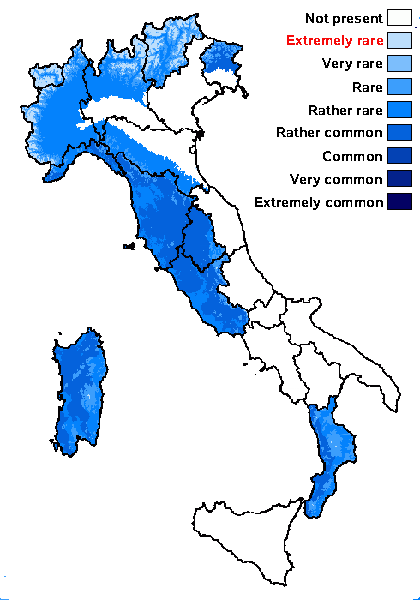
Predictive model
Herbarium samples

Bernard Bouffinier - Source:http://www.lichensmaritimes.org/index.php?task=fiche&lichen=350&lang=en
France, St. Herbot
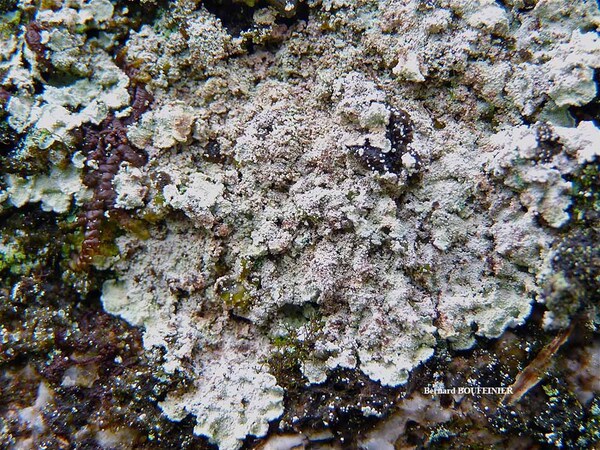
Bernard Bouffinier - Source:http://www.lichensmaritimes.org/index.php?task=fiche&lichen=350&lang=en
France, St. Herbot
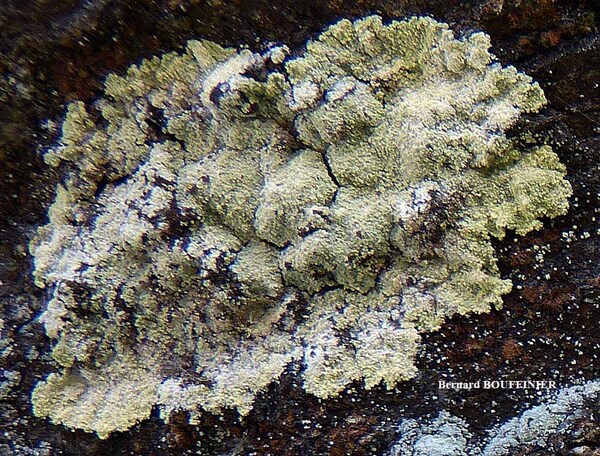
Bernard Bouffinier - Source:http://www.lichensmaritimes.org/index.php?task=fiche&lichen=350&lang=en
France, Roc'h Trédudon

Bernard Bouffinier - Source:http://www.lichensmaritimes.org/index.php?task=fiche&lichen=350&lang=en
France, Roc'h Trédudon
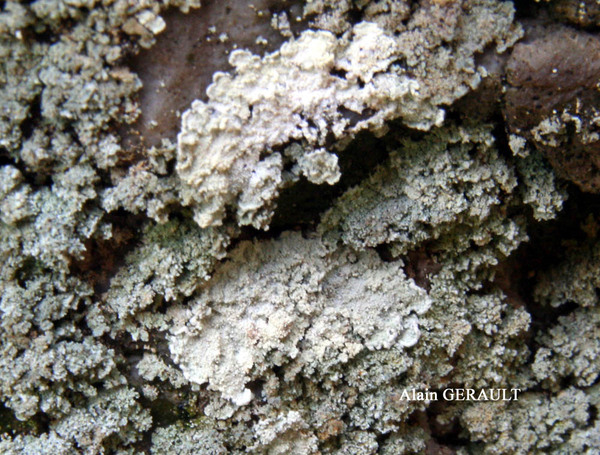
Alain Gerault - Source:http://www.lichensmaritimes.org/index.php?task=fiche&lichen=350&lang=en
France, Argol
Growth form: Leprose
Substrata: rocks, bark, soil, terricolous mosses, and plant debris
Photobiont: green algae other than Trentepohlia
Reproductive strategy: mainly asexual, by soredia, or soredia-like structures (e.g. blastidia)
In underhangs rarely wetted by rain
Commonnes-rarity: (info)
Alpine belt: extremely rare
Subalpine belt: very rare
Oromediterranean belt: extremely rare
Montane belt: rare
Submediterranean belt: rather rare
Padanian area: absent
Humid submediterranean belt: rather common
Humid mediterranean belt: rather rare
Dry mediterranean belt: rare

Predictive model
| Herbarium samples |

Bernard Bouffinier - Source:http://www.lichensmaritimes.org/index.php?task=fiche&lichen=350&lang=en
France, St. Herbot

Bernard Bouffinier - Source:http://www.lichensmaritimes.org/index.php?task=fiche&lichen=350&lang=en
France, St. Herbot

Bernard Bouffinier - Source:http://www.lichensmaritimes.org/index.php?task=fiche&lichen=350&lang=en
France, Roc'h Trédudon

Bernard Bouffinier - Source:http://www.lichensmaritimes.org/index.php?task=fiche&lichen=350&lang=en
France, Roc'h Trédudon

 Index Fungorum
Index Fungorum
 GBIF
GBIF
